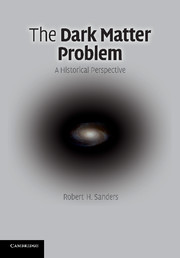Book contents
- Frontmatter
- Contents
- Acknowledgements
- 1 Introduction
- 2 Early history of the dark matter hypothesis
- 3 The stability of disk galaxies: the dark-halo solution
- 4 Direct evidence: extended rotation curves of spiral galaxies
- 5 The maximum-disk: light traces mass
- 6 Cosmology and the birth of astroparticle physics
- 7 Clusters revisited: missing mass found
- 8 CDM confronts galaxy rotation curves
- 9 The new cosmology: introducing dark energy
- 10 An alternative to dark matter: modified Newtonian dynamics
- 11 Seeing dark matter: the theory and practice of detection
- 12 Reflections: a personal point of view
- Appendix Astronomy made simple
- References
- Index
3 - The stability of disk galaxies: the dark-halo solution
Published online by Cambridge University Press: 05 July 2014
- Frontmatter
- Contents
- Acknowledgements
- 1 Introduction
- 2 Early history of the dark matter hypothesis
- 3 The stability of disk galaxies: the dark-halo solution
- 4 Direct evidence: extended rotation curves of spiral galaxies
- 5 The maximum-disk: light traces mass
- 6 Cosmology and the birth of astroparticle physics
- 7 Clusters revisited: missing mass found
- 8 CDM confronts galaxy rotation curves
- 9 The new cosmology: introducing dark energy
- 10 An alternative to dark matter: modified Newtonian dynamics
- 11 Seeing dark matter: the theory and practice of detection
- 12 Reflections: a personal point of view
- Appendix Astronomy made simple
- References
- Index
Summary
Building disk galaxies: too hot to be real
In the early 1960s, computing power, measured either in terms of calculations per unit time or rapid access memory capacity, appeared to undergo an enormous, almost discontinuous, leap forward. This development resulted primarily from the replacement of vacuum tubes by transistors, and now, viewed on the timescale of a century, we know that it is only one segment of an exponential curve describing the time evolution of computing power – a phenomenon encapsulated in the famous Moore's law: by any means of measuring it, computing power doubles every two years. With respect to theoretical astrophysics, this meant that by 1960 it had become practical to apply electronic computing machines in the numerical solution of complex problems such as solving for the structure and evolution of stars or the transfer of radiation at various wavelengths through stellar atmospheres.
By mid-decade several innovative astrophysicists and dynamicists were considering the computer solution of the Newtonian N-body problem where N was considerably larger than a few – in fact, on the order of 100000. The problem is straightforward: set up a system of particles each with a prescribed mass, calculate the Newtonian gravitational field generated by these particles, and then let them move under the influence of this force field for a short interval of time. Of course, after this interval, because the particles have rearranged themselves, the force has to be recalculated before the particles are moved further.
- Type
- Chapter
- Information
- The Dark Matter ProblemA Historical Perspective, pp. 26 - 37Publisher: Cambridge University PressPrint publication year: 2010



